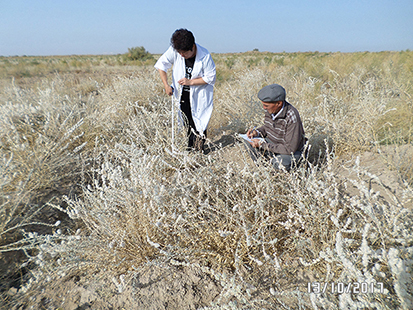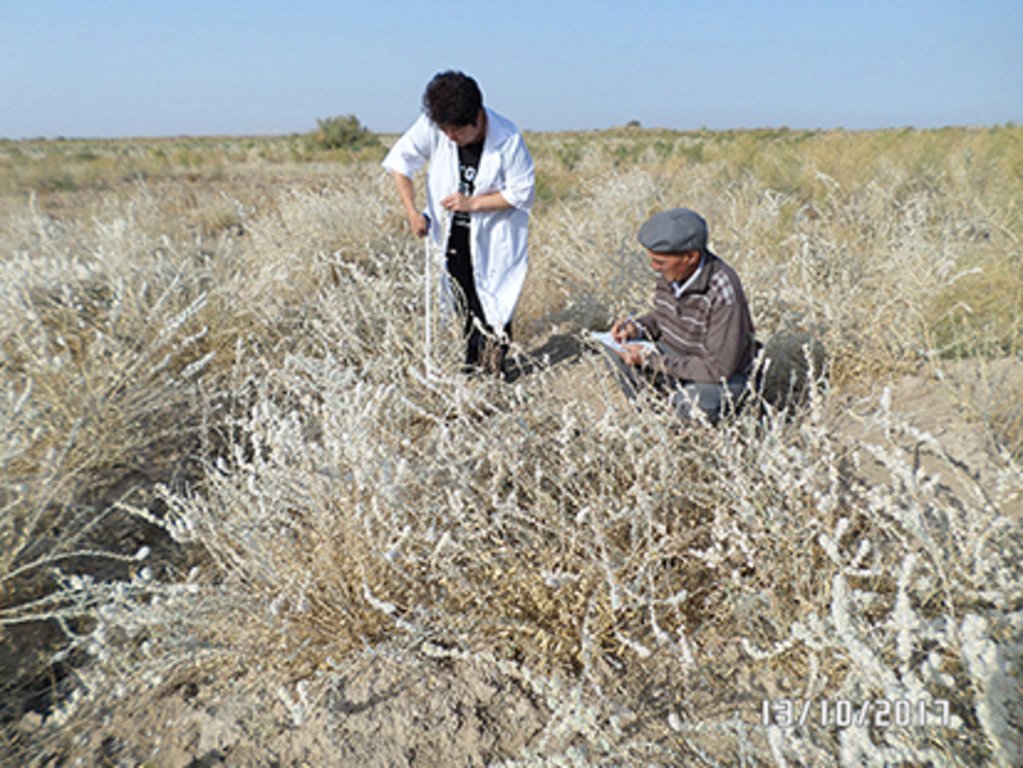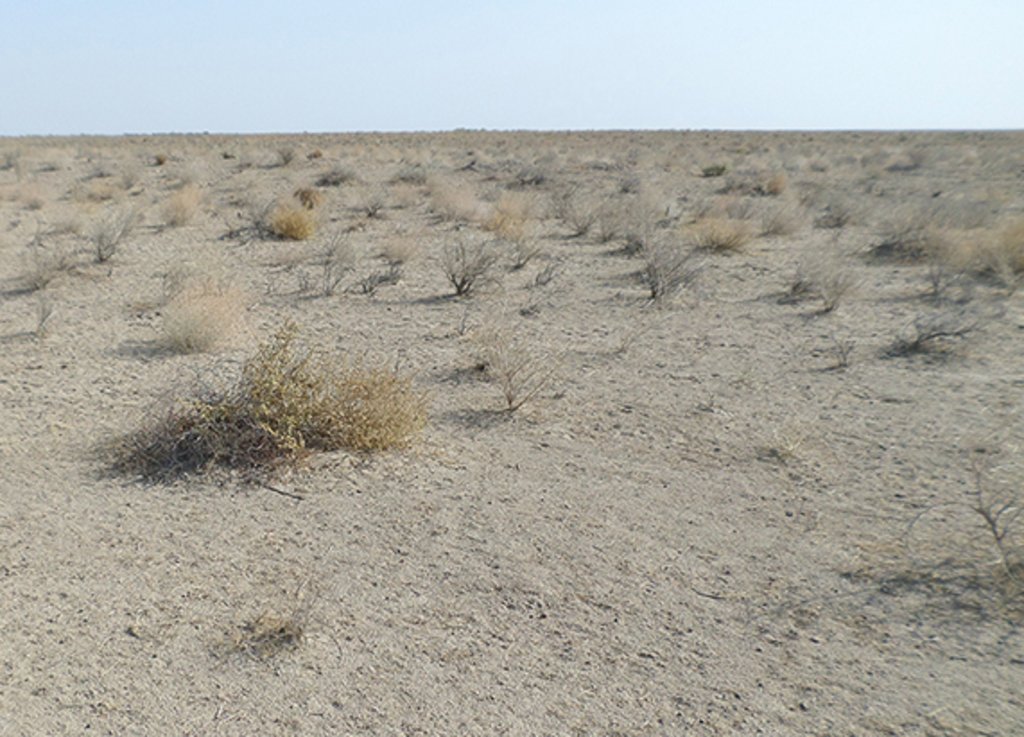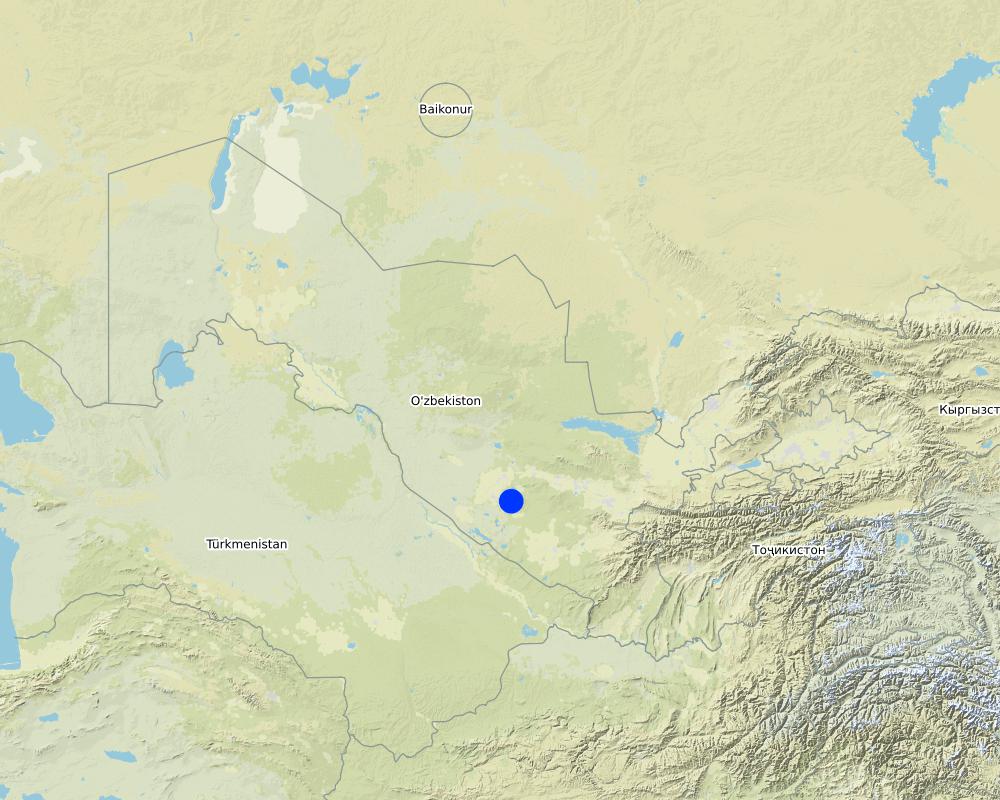Creation of improved autumn-winter pastures in the foothill zone of Uzbekistan [Uzbekistan]
- Creation:
- Update:
- Compiler: Rustam Ibragimov
- Editor: –
- Reviewers: Elizaveta Soloveyva, Olga Andreeva, Alexandra Gavilano
Creation of improved autumn-winter pastures in the foothill zone of Uzbekistan
technologies_4040 - Uzbekistan
- Full summary as PDF
- Full summary as PDF for print
- Full summary in the browser
- Full summary (unformatted)
- Создание осенне-зимних пастбищ в предгорной зоне Узбекистана: Nov. 7, 2018 (inactive)
- Создание осенне-зимних пастбищ в предгорной зоне Узбекистана: March 18, 2019 (inactive)
- Создание осенне-зимних пастбищ в предгорной зоне Узбекистана: Aug. 22, 2019 (inactive)
- Creation of improved autumn-winter pastures in the foothill zone of Uzbekistan: Feb. 4, 2020 (public)
View sections
Expand all Collapse all1. General information
1.2 Contact details of resource persons and institutions involved in the assessment and documentation of the Technology
Key resource person(s)
SLM specialist:
Bobokulov Nasillo, Asadovich
Research Institute of Karakul Breeding and Desert Ecology
Uzbekistan
SLM specialist:
Mukimov Tolibjon, Hudaikulovich
Research Institute of Karakul Breeding and Desert Ecology
Uzbekistan
SLM specialist:
Rabbimov Abdullo, Rabbinovich
Research Institute of Karakul Breeding and Desert Ecology
Uzbekistan
SLM specialist:
Toderich Christine, N.
ICARDA
Uzbekistan
Name of project which facilitated the documentation/ evaluation of the Technology (if relevant)
Decision Support for Mainstreaming and Scaling out Sustainable Land Management (GEF-FAO / DS-SLM)1.3 Conditions regarding the use of data documented through WOCAT
The compiler and key resource person(s) accept the conditions regarding the use of data documented through WOCAT:
Yes
1.4 Declaration on sustainability of the described Technology
Is the Technology described here problematic with regard to land degradation, so that it cannot be declared a sustainable land management technology?
No
2. Description of the SLM Technology
2.1 Short description of the Technology
Definition of the Technology:
The Technology allows to introduce new forage crops, to increase the grass density, to develop multicomponent pasture phytocenoses, that provide productivity increase of degraded pastures by 2-3 times without disturbing the vegetation cover
2.2 Detailed description of the Technology
Description:
Pasture lands in Uzbekistan are located in a desert and semi-desert zone with low resource potential and occupy about 20 million hectares. Unsustainable use of pastures is the main cause of pasture degradation. There is an imbalance in the stocking level: some places are undergrazed, others suffer from excessive grazing. The difference in the amount of summer and winter feed stocks leads to overgrazing of some winter pastures.
When creating improved autumn-winter pastures, the selected area is divided into alternating strips of 12 m and 25 m width. The 12 m width spaces are left in the case of poor grass, and the 25 m width spaces are left in case when the state of grass pastures is moderate, but it needs to be enriched with species for autumn-winter grazing. There are prospective varieties of desert forage plants used to increase pasture productivity: Haloxylon aphyllum, Kochia prostrata, Ceratoides eversmanniana, Salsola orientalis, Aellenia subaphylla, Agropyron desertorum, Atriplex undulata. Soil preparation includes plowing with simultaneous harrowing or rolling with ring rollers, or leveling. Plowing reduces the competitive ability of natural vegetation and stimulates soil moisture accumulation and conservation. The best time for plowing is the autumn-winter period after rainfall, when the soil is moistened to the depth of plowing. On light and medium-sized soils without strong swarding, plowing can also be carried out in summer. The sowing period is of particular importance in the conditions of deserts and semi-deserts. The following sowing periods are recommended for wild forage plants: Artemisia, Aellenia subaphylla - from late November to mid January; Kochia prostratа, Salsola оrientalis - mid December to mid February. It is recommended to sow in rainy weather, under snow or in the snow. Sowing is carried out by traditional grain seeders, as well as grain-grass seeders, with row spacing of 60 cm. To improve flowability, the seeds are mixed with manure and dry sand in a ratio of 1:5. Seeding in the soil is done by rolling ring rollers. The seeding rate is: Haloxylon aphyllum -5kg / Salsola Richteri 10-12kg / ha, Aellenia subaphylla 8-10kg/g, Kochia prostratа 3kg / ha, Salsola оrientalis 6-7 kg / ha, Artemisia 3-4 kg / ha, Camphorosma 3-4 kg / ha, Poa bulbosa 3 kg / ha. The additional sowing of perennial forage crops will increase the productivity of pastures by 2-3 times. In the first year of vegetation, plants of these species produce 1.5-1.6 C / ha of dry mass, in the second year-2.2-3.5 C / ha of dry mass and about 0.4 C / ha of seeds. Starting from the third year, the harvest is 8-12 kg / ha of dry fodder weight and 1.0-1.2 kg / ha of seeds. Kochia prostratа, Salsola оrientalis, Atriplex undulata can be mow down 2 times during the year. The sheep grazing at permissible load can be done in spring and autumn to get easy-to-eat forage by autumn. If the vegetation cover is used for 70-75% the possibility of self-regeneration of pastures remains and plant communities are able to regenerate themselves for a long time (20-25 years). Ripe seeds are carried by wind, animals and spread over large areas. The creation of improved long-term pasture agrophytocenoses for various purposes (pasture, hay) and terms of use (spring-summer, autumn-winter, year-round) will allow cattle grazing on such pastures throughout the year.
2.3 Photos of the Technology
2.5 Country/ region/ locations where the Technology has been applied and which are covered by this assessment
Country:
Uzbekistan
Region/ State/ Province:
Kagan district Bukhara region, Zaamin district of Jizzakh region
Further specification of location:
Kagan district/Zirobod, Zaamin district/region
Specify the spread of the Technology:
- evenly spread over an area
If precise area is not known, indicate approximate area covered:
- 0.1-1 km2
Comments:
The Technology is implemented in degraded pasture areas
Map
×2.6 Date of implementation
Indicate year of implementation:
2005
If precise year is not known, indicate approximate date:
- 10-50 years ago
2.7 Introduction of the Technology
Specify how the Technology was introduced:
- during experiments/ research
- through projects/ external interventions
Comments (type of project, etc.):
The Technology is being implemented within the framework of the Institute of Karakul breeding and desert ecology and through projects aimed at pasture management improving
3. Classification of the SLM Technology
3.1 Main purpose(s) of the Technology
- improve production
- reduce, prevent, restore land degradation
- preserve/ improve biodiversity
3.2 Current land use type(s) where the Technology is applied

Grazing land
Extensive grazing:
- Semi-nomadic pastoralism
- Small and large cattle, wool, karakul and meat, milk
3.3 Has land use changed due to the implementation of the Technology?
Has land use changed due to the implementation of the Technology?
- Yes (Please fill out the questions below with regard to the land use before implementation of the Technology)
Comments:
no change
3.4 Water supply
Water supply for the land on which the Technology is applied:
- rainfed
Comments:
Number of growing seasons per year: 2
Specify:
Natural and climatic conditions of Uzbekistan allow to get 2 crops per year of short growing season crops (vegetables, potatoes), or when they are cultivated after harvesting winter wheat. Major crops - cotton and wheat produce 1 crop / year. The additional sowing of desert plants on the poor grass areas contributes to the restoration of degraded lands
(ripe seeds are carried by the wind, animals and spread over large areas). Enrichment of pastures with plants provides
creation of long-term pasture agrophytocenoses preventing deflation and water erosion allow to get 2 crops per year of short growing season crops (vegetables, potatoes), or when they are cultivated after harvesting winter wheat. Major crops - cotton and wheat produce 1 crop / year
3.5 SLM group to which the Technology belongs
- improved ground/ vegetation cover
3.6 SLM measures comprising the Technology

vegetative measures
- V2: Grasses and perennial herbaceous plants
3.7 Main types of land degradation addressed by the Technology

soil erosion by water
- Wt: loss of topsoil/ surface erosion

soil erosion by wind
- Et: loss of topsoil
Comments:
Water, wind erosion and biological degradation are caused by natural factors (low rainfall, high temperatures and evaporation from the soil) and irrational pastures management (exceeding the pasture capacity, lack of rotation), which lead to the degradation of the vegetation cover, and increase the proportion of bare/unprotected surface, increasing the risk of erosion.
3.8 Prevention, reduction, or restoration of land degradation
Specify the goal of the Technology with regard to land degradation:
- reduce land degradation
- restore/ rehabilitate severely degraded land
Comments:
The additional sowing of desert plants on the poor grass areas contributes to the restoration of degraded lands (ripe seeds are carried by the wind, animals and spread over large areas). Enrichment of pastures with plants provides creation of long-term pasture agrophytocenoses preventing deflation and water erosion.
4. Technical specifications, implementation activities, inputs, and costs
4.1 Technical drawing of the Technology
Technical specifications (related to technical drawing):
When creating improved autumn-winter pastures, the selected area is divided into alternating strips of 12 m and 25 m width. The 12 m width spaces are left in the case of poor grass, and the 25 m width spaces are left in case when the state of grass pastures is moderate, but it needs to be enriched with species for autumn-winter grazing. 25 meters wide stripes are sown by Kochia, Salsola, Ceratoides, Halothamnus, Agropyron. Sowing is carried out by traditional grain seeders, as well as grain-grass seeders, with row spacing of 60 cm.
Author:
R. Ibrahimov
Date:
05/09/2018
4.2 General information regarding the calculation of inputs and costs
Specify how costs and inputs were calculated:
- per Technology area
Indicate size and area unit:
1 ha
Specify currency used for cost calculations:
- USD
If relevant, indicate exchange rate from USD to local currency (e.g. 1 USD = 79.9 Brazilian Real): 1 USD =:
4500.0
Indicate average wage cost of hired labour per day:
about 10 USD
4.3 Establishment activities
| Activity | Timing (season) | |
|---|---|---|
| 1. | Soil preparation: plowing, harrowing, leveling | December-February |
| 2. | Sowing | December-February |
| 3. | Crop care: pest and weed control | March-September |
| 4. | Harvesting seeds | October-November |
4.4 Costs and inputs needed for establishment
| Specify input | Unit | Quantity | Costs per Unit | Total costs per input | % of costs borne by land users | |
|---|---|---|---|---|---|---|
| Labour | Hired labor during the growing season for crops care, harvesting | USD/ha | 1.0 | 35.0 | 35.0 | |
| Equipment | Use of machinery (tillage, sowing) | USD/ha | 1.0 | 135.0 | 135.0 | |
| Plant material | Seeds | USD/ha | 1.0 | 55.0 | 55.0 | |
| Total costs for establishment of the Technology | 225.0 | |||||
| Total costs for establishment of the Technology in USD | 0.05 | |||||
If land user bore less than 100% of costs, indicate who covered the remaining costs:
costs were covered by the project
Comments:
The highest costs relate to the machinery use (including fuels) and to the tillage and sowing
4.5 Maintenance/ recurrent activities
| Activity | Timing/ frequency | |
|---|---|---|
| 1. | Cut tor hay | October-November |
| 2. | Seed harvest and drying | October-November |
Comments:
To maintain the Technology, it is necessary to keep the optimal pasture capacity, prevent overgrazing, partially mow and harvest seeds for the Technology introduction in other areas.
4.6 Costs and inputs needed for maintenance/ recurrent activities (per year)
| Specify input | Unit | Quantity | Costs per Unit | Total costs per input | % of costs borne by land users | |
|---|---|---|---|---|---|---|
| Labour | Salary | USD/ha | 1.0 | 13.0 | 13.0 | 100.0 |
| Equipment | Use of machinery | USD/ha | 1.0 | 44.0 | 44.0 | 100.0 |
| Total costs for maintenance of the Technology | 57.0 | |||||
| Total costs for maintenance of the Technology in USD | 0.01 | |||||
If you are unable to break down the costs in the table above, give an estimation of the total costs of maintaining the Technology:
57.0
Comments:
The most costs are related to the machinery use
4.7 Most important factors affecting the costs
Describe the most determinate factors affecting the costs:
Maintenance of Technology practically does not require imputs, it is nessessary to provide optimum management and pasture capacity. The competent management will ensure pasture productivity for 20-25 years
5. Natural and human environment
5.1 Climate
Annual rainfall
- < 250 mm
- 251-500 mm
- 501-750 mm
- 751-1,000 mm
- 1,001-1,500 mm
- 1,501-2,000 mm
- 2,001-3,000 mm
- 3,001-4,000 mm
- > 4,000 mm
Specifications/ comments on rainfall:
96% of precipitation falls during the October-May
Indicate the name of the reference meteorological station considered:
Navoi, Jizzakh
Agro-climatic zone
- semi-arid
The duration of the growing season is 170 days
5.2 Topography
Slopes on average:
- flat (0-2%)
- gentle (3-5%)
- moderate (6-10%)
- rolling (11-15%)
- hilly (16-30%)
- steep (31-60%)
- very steep (>60%)
Landforms:
- plateau/plains
- ridges
- mountain slopes
- hill slopes
- footslopes
- valley floors
Altitudinal zone:
- 0-100 m a.s.l.
- 101-500 m a.s.l.
- 501-1,000 m a.s.l.
- 1,001-1,500 m a.s.l.
- 1,501-2,000 m a.s.l.
- 2,001-2,500 m a.s.l.
- 2,501-3,000 m a.s.l.
- 3,001-4,000 m a.s.l.
- > 4,000 m a.s.l.
Indicate if the Technology is specifically applied in:
- not relevant
5.3 Soils
Soil depth on average:
- very shallow (0-20 cm)
- shallow (21-50 cm)
- moderately deep (51-80 cm)
- deep (81-120 cm)
- very deep (> 120 cm)
Soil texture (topsoil):
- medium (loamy, silty)
Soil texture (> 20 cm below surface):
- medium (loamy, silty)
Topsoil organic matter:
- low (<1%)
5.4 Water availability and quality
Ground water table:
> 50 m
Availability of surface water:
medium
Water quality (untreated):
good drinking water
Is water salinity a problem?
Yes
Specify:
In the foothills (on adyrs) surface waters are not mineralized and not polluted
Is flooding of the area occurring?
No
5.5 Biodiversity
Species diversity:
- medium
Habitat diversity:
- medium
Comments and further specifications on biodiversity:
Pasture vegetation is represented on the adyras (hilly-withered foothills) by a mixture of sedge-bluegrass vegetation. The best forage plants in these pastures are Carex pachystylis, Carex pachystylis, ROA bulbosa. In addition, valuable species are Leptaleum filifolium, Astragalus filicanlis, Bromus tectorum, etc. Occasionally there are Salsola carinata, Ceratocarpus turkestanicus, Malcomia Euclidium, Stereptoloma, legume and ephemeral grasses.
5.6 Characteristics of land users applying the Technology
Sedentary or nomadic:
- Semi-nomadic
Market orientation of production system:
- mixed (subsistence/ commercial)
Off-farm income:
- less than 10% of all income
Relative level of wealth:
- average
Individuals or groups:
- individual/ household
Level of mechanization:
- mechanized/ motorized
Gender:
- men
Age of land users:
- middle-aged
Indicate other relevant characteristics of the land users:
Men are traditionally the main land users.
5.7 Average area of land used by land users applying the Technology
- < 0.5 ha
- 0.5-1 ha
- 1-2 ha
- 2-5 ha
- 5-15 ha
- 15-50 ha
- 50-100 ha
- 100-500 ha
- 500-1,000 ha
- 1,000-10,000 ha
- > 10,000 ha
Is this considered small-, medium- or large-scale (referring to local context)?
- medium-scale
5.8 Land ownership, land use rights, and water use rights
Land ownership:
- state
Land use rights:
- leased
Water use rights:
- individual
Comments:
The land is in state ownership. Farmers use pastures on a long-term lease basis for up to 50 years.
5.9 Access to services and infrastructure
health:
- poor
- moderate
- good
education:
- poor
- moderate
- good
technical assistance:
- poor
- moderate
- good
employment (e.g. off-farm):
- poor
- moderate
- good
markets:
- poor
- moderate
- good
energy:
- poor
- moderate
- good
roads and transport:
- poor
- moderate
- good
drinking water and sanitation:
- poor
- moderate
- good
financial services:
- poor
- moderate
- good
6. Impacts and concluding statements
6.1 On-site impacts the Technology has shown
Socio-economic impacts
Production
crop production
fodder production
animal production
Income and costs
farm income
Ecological impacts
Soil
nutrient cycling/ recharge
soil organic matter/ below ground C
Biodiversity: vegetation, animals
Vegetation cover
biomass/ above ground C
plant diversity
animal diversity
6.2 Off-site impacts the Technology has shown
Specify assessment of off-site impacts (measurements):
Technology has a positive off-site impact
6.3 Exposure and sensitivity of the Technology to gradual climate change and climate-related extremes/ disasters (as perceived by land users)
Gradual climate change
Gradual climate change
| Season | increase or decrease | How does the Technology cope with it? | |
|---|---|---|---|
| annual temperature | increase | very well | |
| seasonal temperature | summer | increase | well |
| annual rainfall | decrease | moderately | |
| seasonal rainfall | spring | decrease | moderately |
| seasonal rainfall | summer | decrease | moderately |
Climate-related extremes (disasters)
Climatological disasters
| How does the Technology cope with it? | |
|---|---|
| heatwave | moderately |
| drought | moderately |
Other climate-related consequences
Other climate-related consequences
| How does the Technology cope with it? | |
|---|---|
| extended growing period | moderately |
6.4 Cost-benefit analysis
How do the benefits compare with the establishment costs (from land users’ perspective)?
Short-term returns:
positive
Long-term returns:
positive
How do the benefits compare with the maintenance/ recurrent costs (from land users' perspective)?
Short-term returns:
positive
Long-term returns:
very positive
Comments:
The Technology is low-cost, so the profit is obtained in the short term. After 2-3 years, the seed yield is about 120 kg / ha and the yield of dry fodder mass up to 18.0 kg / ha. the Technology does not require additional costs after sowing fodder crops. With the use of pasture management plants are able to regenerate within 20-25 years.
6.5 Adoption of the Technology
- 11-50%
Of all those who have adopted the Technology, how many did so spontaneously, i.e. without receiving any material incentives/ payments?
- 11-50%
6.6 Adaptation
Has the Technology been modified recently to adapt to changing conditions?
No
6.7 Strengths/ advantages/ opportunities of the Technology
| Strengths/ advantages/ opportunities in the land user’s view |
|---|
| The Technology is inexpensive, uncomplicated, all measures for tillage, sowing and crpo care are well known |
| The Technology helps to obtain additional feed in the winter |
| Strengths/ advantages/ opportunities in the compiler’s or other key resource person’s view |
|---|
| The Technology is uncomplicated and does not require high imputs for implementation |
| The technology gives a quick profit for 2-3 years |
| Native species of desert forage plants are used to enrich pastures with plants for autumn-winter grazing |
| There is a possibility of obtaining additional income through the sale of seeds of fodder plants. |
6.8 Weaknesses/ disadvantages/ risks of the Technology and ways of overcoming them
| Weaknesses/ disadvantages/ risks in the land user’s view | How can they be overcome? |
|---|---|
| Although the technology is inexpensive and simple, but for many farmers it is new one, so they do not have enough awareness about the methods of improving pastures | Trainings, propagation of instructions and recommendations, creation of demonstration sites for awareness raising of the technology costs and benefits |
| At the state level, there are no specific requirements for the creation of autumn-winter pastures. Stakeholder responsibilities are not defined | The duties and responsibilities of stakeholders should be defined, and incentive mechanisms for pasture users implementing phytomeliorative measures should be developed. |
| There is a shortage of seed material to create autumn-winter pastures | Assistance of the company "Uzbek karakuli" in the acquisition of seeds |
| Weaknesses/ disadvantages/ risks in the compiler’s or other key resource person’s view | How can they be overcome? |
|---|---|
| Lack of awareness of pasture users about the phyto-reclamation improvement methods | Training of key stakeholders and dissemination of information (instructions and recommendations), the creation of demonstration sites |
| Absence of state or public structures promoting the development of phytomeliorative measures. | Involvement of local people to the creation of autumn-winter pastures through the use of traditional methods of organizing joint events (khashars) |
| At the state level, responsibilities and measures for the establishment of autumn-winter pastures are not defined due to insufficient assessment of phytomelioration impact | Develop further studies to assess the impact of phytomelioration for the decision making at the state level. |
| Stakeholder responsibilities are not defined | To determine the responsibility of stakeholders, and to develop a mechanism to encourage pasture users to create autumn-winter pastures |
7. References and links
7.1 Methods/ sources of information
- interviews with SLM specialists/ experts
3 persons
- compilation from reports and other existing documentation
When were the data compiled (in the field)?
2017
7.2 References to available publications
Title, author, year, ISBN:
Yusupov S. Yu., Mukimov T. Pastures of Uzbekistan and their rational use. Tashkent, 2009, 128 p.
Title, author, year, ISBN:
Rabbimov A., Mukimov T. Recommendations on rational use and increase of productivity of desert pastures. Recommendations, Tashkent, 2012, p. 48
Title, author, year, ISBN:
Rabbimov A., Mukimov T. intensification of forage production in the desert -the main way of modernization of desert-pasture livestock. Chal - Yalov carbacholine modernizational muammolari. Republic of Ilmi – Amali of conferencesi of materiallari Samarkand, 2012, pp. 308-315
Title, author, year, ISBN:
Rabbimov A., Mukimov T., Bekchanov B., boboeva A. Phytomelioration of pastures in Uzbekistan and its necessity in combating desertification and degradation Actual issues of development of productive camel breeding in Kazakhstan. Shymkent, 2014, p. 265-269
Title, author, year, ISBN:
Rabbimov A., Mukimov T., Bekchanov B., Khamraeva G., Babaeva A. Some results of introduction and selection works with desert fodder plants in Uzbekistan. Scientific bases and practical methods of forage preparation and feeding of farm animals in Kazakhstan: achievements and prospects. International scientific and practical conference. Almaty, 2015, 143-149 b.
7.3 Links to relevant online information
Title/ description:
Toderich K. N., Bobokulov N., Rabimov A., Shuiskaya E. Mukimov T., Popova V., Khakimov U. Kochia Prostrata (L.) Shred-Valuable forage plant for improvement of desert and semi-desert pastures Tashkent,2014, 152 p.
URL:
http://www.biosaline.org/pdf/Kochia-Prostrata-Book.pdf
Title/ description:
Rabbimov A., Mukimov T., Rabbimov F. Ways of rational nature management on pasture ecosystems of Uzbekistan. International scientific and practical Internet conference "Modern ecological state of the natural environment and scientific and practical aspects of rational nature management" February 29, 2016, - S. Salty zaymishche web-site of the Caspian research Institute of arid agriculture
URL:
www.pniiaz.ru
Title/ description:
Tolib Mukimov Uzbekistan - Rangelands and Pasturelands: Problems and Prospects Chapter 12 Rangelands along the Silk Road: Transformative Adaptation under Climate and Global Change. Editors: Victor Roy Squires, Shang Zhan-Huan and Ali Ariapour (International Dryland Management Consultant, Adelaide, Australia, and others) NOVA, 2017, 217-231
URL:
https://www.novapublishers.com/catalog/product_info.php?products_id=60416
Links and modules
Expand all Collapse allLinks
No links
Modules
No modules





